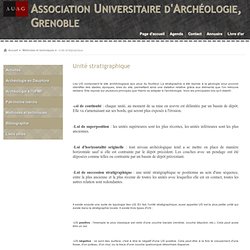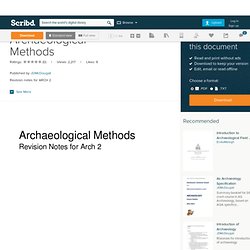

The Harris Matrix Program. Harris Matrix Composer. The Harris-Matrix Program. In Archaeology, the dating of objects is not only obtained by absolute dating evidence ( like radiocarbon dating ), but also by relative dating evidence.

Relative dating of archaeological contexts is better known as stratigraphy.Archaeological stratigraphy was systematized in the early 70´s by E.Harris when he was confronted with an extremely complex excavation in Winchester. Harris describes layers as the smallest units of archaeological identification.Beside their spatial dimensions, these layers also have a time dimension. As a result he developed the so-called "Harris-Matrix" to describe the time relationships between layers.
In a Harris Matrix, layers are represented as rectangles containing the name of that layer.The relations are drawn as lines and the positions of the connected rectangles describe the type of the relation. The basic relations between two layers ( let us call them 1 and 2 ) are : 1 is later than 3, 3 is contemporary with 2, 2 is later than 4. Stratify. Inora-18-5. Unité stratigraphique - Matrice de Harris - Association Universitaire d'Archéologie, Grenoble. Les US composent le site archéologique aux yeux du fouilleur.

La stratigraphie a été reprise à la géologie pour pouvoir identifier des stades, époques, ères du site, permettant ainsi une datation relative grâce aux éléments que l'on retrouve dedans. Elle repose sur plusieurs principes que Harris va adapter à l'archéologie. Voici les principales lois qu'il établit : -Loi de continuité : chaque unité, au moment de sa mise en œuvre est délimitée par un bassin de dépôt. Elle va s'amenuisant sur ses bords, qui seront plus exposés à l'érosion. -Loi de superposition : les unités supérieures sont les plus récentes, les unités inférieures sont les plus anciennes. -Loi d'horizontalité originelle : tout niveau archéologique tend a se mettre en place de manière horizontale sauf si elle est contrainte par le dépôt précédent.
Il existe ensuite une sorte de typologie des US. -US positive : l'exemple le plus classique est celle d'une couche banale (remblai, couche dépotoir, etc.). Le Fait Archéologique. Du temps ordonné au temps quantifié : application d'outils mathématiques au modèle d'analyse stratigraphique d'Edward Harris - article ; n°4 ; vol.102, pg 729-740 - Bruno Desachy - Savoirs. Harris matrix for Archaeological Methods. Excavation (archaeology)1 Excavation (archaeology) Excavations at the site of Gran Dolina, in theAtapuerca Mountains, Spain, 2008Excavations at the cave of Santa Ana (Cáceres,Extremadura, Spain) The term archaeological excavation has a double meaning.1.Excavation is best known and most commonly used within thescience of archaeology.

Exposure processing and recording of archaeological remains.2.The term is also used for an example of the application of thetechnique to the study of a given site. Dig " by those who participate,this being a concise, if oversimplified description of the process.Such a site excavation concerns itself with a specific archaeologicalsite or a connected series of sites, and may be conducted over aslittle as several weeks to over a number of years. Overview Within the practice of excavation, numerous specialized techniques areavailable for use, and each dig will have its particular features, whichwill determine the archaeologists' approach. Historical development.